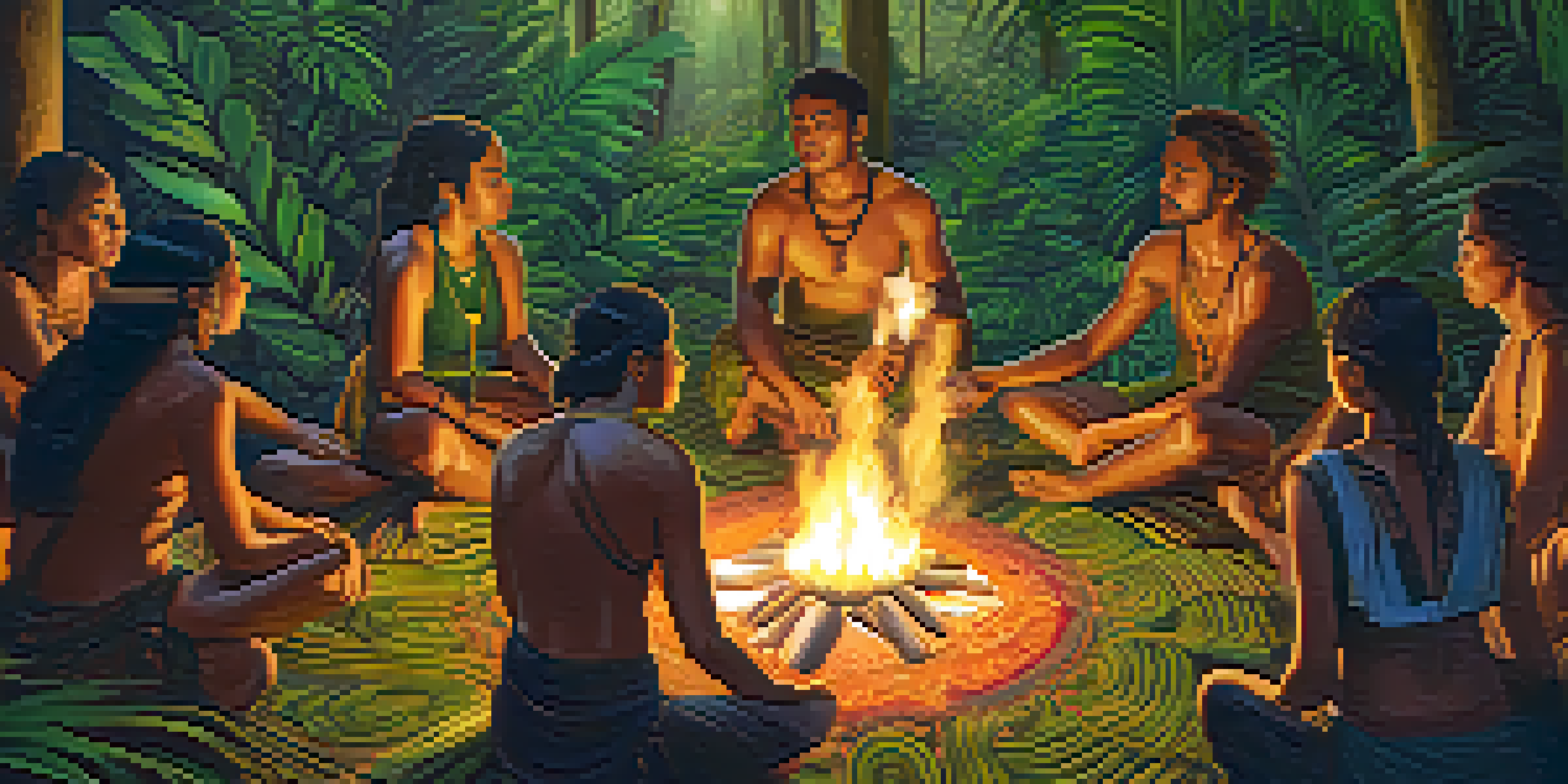Masculine vs. Feminine Energies in Ayahuasca Ceremonies

Understanding Masculine and Feminine Energies
Masculine and feminine energies are not strictly tied to gender; they represent traits and qualities that everyone can possess. Masculine energy often embodies action, logic, and assertiveness, while feminine energy is more about intuition, nurturing, and receptivity. In ayahuasca ceremonies, these energies manifest in various ways, influencing participants' experiences and interactions.
The greatest thing in the world is to know how to belong to oneself.
For instance, a person embodying masculine energy may take a more proactive role during the ceremony, leading discussions or making decisions. On the other hand, someone with feminine energy might focus on emotional connection, fostering a sense of community and support among participants. This balance creates a richer, more holistic experience for everyone involved.
Understanding these energies helps participants navigate their own roles within the ceremony. It encourages self-reflection, allowing individuals to identify which energy they resonate with and how it impacts their journey. This awareness can lead to personal growth and transformation during the ayahuasca experience.
The Role of Masculine Energy in Ayahuasca Ceremonies
Masculine energy plays a vital role in ayahuasca ceremonies, often driving the structure and direction of the experience. It typically manifests through leadership, assertiveness, and the establishment of boundaries, which can create a safe environment for participants. This energy can also encourage individuals to confront their fears head-on, pushing them toward healing and growth.

In some ceremonies, the shaman or facilitator embodies this masculine energy, guiding participants with confidence and clarity. Their presence can instill a sense of security, allowing others to explore their inner landscapes without feeling lost or overwhelmed. This dynamic is crucial, as it sets the stage for deep, transformative work.
Understanding Energies Beyond Gender
Masculine and feminine energies represent traits that everyone can embody, influencing personal growth and experiences in ayahuasca ceremonies.
Furthermore, masculine energy can encourage participants to take ownership of their experiences. By asserting their intentions and being proactive in their healing, individuals can tap into their inner strength, learning to navigate challenges with determination and resilience. This empowerment is a key element of the ayahuasca journey.
The Role of Feminine Energy in Ayahuasca Ceremonies
Feminine energy in ayahuasca ceremonies often represents healing, compassion, and emotional support. This energy fosters connection among participants, creating an atmosphere of trust and vulnerability. As individuals share their experiences and emotions, the nurturing aspect of feminine energy helps to process and integrate these feelings.
In the middle of difficulty lies opportunity.
During ceremonies, the presence of feminine energy can be felt in the way participants interact with one another. Moments of empathy, kindness, and understanding flourish, allowing individuals to feel seen and heard. This sense of community can be incredibly powerful, as it encourages deeper exploration of personal issues and traumas.
Additionally, feminine energy invites participants to embrace their intuition and emotional wisdom. By allowing themselves to be vulnerable and receptive, individuals can access profound insights and revelations during their journey. This balance between emotional connection and introspection is essential for healing and transformation.
Balancing Masculine and Feminine Energies
Finding a balance between masculine and feminine energies is crucial for a harmonious ayahuasca ceremony. When both energies are present, participants can engage in a more comprehensive healing process. This balance allows individuals to confront challenges while also nurturing their emotional needs, fostering a holistic approach to self-discovery.
For example, a participant may initially embody masculine energy by setting intentions and taking action. However, as the ceremony unfolds, they might shift into a more feminine space, allowing themselves to feel and process emotions deeply. This fluidity between energies can lead to profound insights and personal growth.
Balancing Energies for Healing
A harmonious blend of masculine and feminine energies enhances the healing process, allowing participants to confront challenges while nurturing emotional needs.
Encouraging this balance can also enhance group dynamics, as participants learn to support one another in their journeys. By celebrating both energies, individuals can create a more inclusive and enriching environment, ultimately leading to a deeper collective experience.
The Impact of Cultural Perspectives on Energies
Cultural perspectives on masculine and feminine energies can significantly influence ayahuasca ceremonies. Different cultures may have varying interpretations of these energies, shaping how they are expressed and experienced. Understanding these cultural nuances is essential for participants seeking to engage meaningfully with the ceremony.
For instance, Indigenous cultures often view these energies as intertwined, emphasizing the importance of balance and harmony. Participants from these backgrounds may approach the ceremony with a deep sense of connection to both energies, enhancing their experience. Conversely, individuals from more rigid cultural backgrounds may struggle to embrace the fluidity of these energies.
Recognizing and respecting these cultural differences can enrich the ceremony for all involved. It opens up conversations about how masculine and feminine energies manifest in different contexts, allowing participants to learn from one another and broaden their understanding of these concepts.
Personal Experiences: Sharing Stories of Energies
Personal stories from participants can illuminate the impact of masculine and feminine energies in ayahuasca ceremonies. Many individuals recount experiences where they felt a strong connection to one energy, leading to profound insights. These anecdotes often highlight the transformative power of embracing both energies during the journey.
For example, one participant may share how embracing their feminine energy during a ceremony allowed them to access emotions they had long suppressed. This vulnerability led to significant healing and a deeper understanding of themselves. Conversely, another participant might discuss how embodying masculine energy helped them confront fears and take decisive steps toward personal growth.
Cultural Perspectives Shape Experiences
Cultural viewpoints on masculine and feminine energies can significantly impact how participants engage with ayahuasca ceremonies, highlighting the importance of understanding these differences.
These stories serve as powerful reminders of the importance of exploring both energies. They illustrate how the interplay of masculine and feminine qualities can lead to unique and transformative experiences, encouraging others to reflect on their journeys.
Integrating Lessons from Ayahuasca into Daily Life
The lessons learned from exploring masculine and feminine energies in ayahuasca ceremonies can be integrated into daily life. Participants often discover new ways to balance these energies within themselves, enhancing their relationships and personal well-being. This integration can lead to a more fulfilling and harmonious existence.
For instance, someone might learn to assert themselves more confidently in their professional life, embodying masculine energy when necessary. Simultaneously, they may also embrace their nurturing side, fostering deeper connections with colleagues and friends. This balance can create a more supportive and collaborative environment.

Ultimately, integrating these lessons encourages ongoing self-reflection and growth. By actively engaging with both masculine and feminine energies, individuals can cultivate a more authentic and holistic approach to life, enriching their experiences and interactions with others.